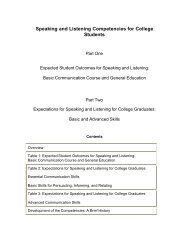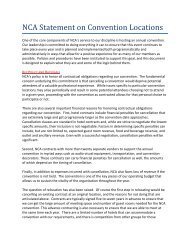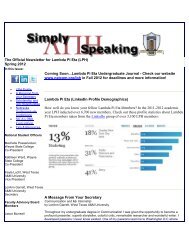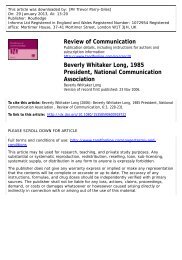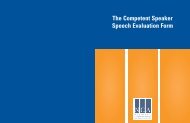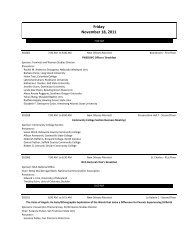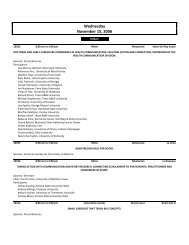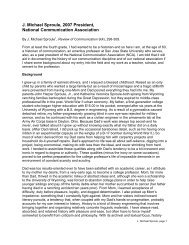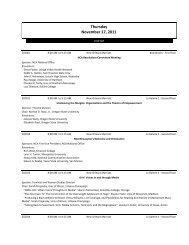Assessing Motivation to Communicate - National Communication ...
Assessing Motivation to Communicate - National Communication ...
Assessing Motivation to Communicate - National Communication ...
- No tags were found...
You also want an ePaper? Increase the reach of your titles
YUMPU automatically turns print PDFs into web optimized ePapers that Google loves.
This study investigated whether cross-cultural differencesin communication apprehension (CA) can be explainedwith regard <strong>to</strong> cultural orientations, personalitytraits and component theory. To this end, a <strong>to</strong>tal of 618undergraduates, studying in Taiwan (n = 298) and theUnited States (n = 320), participated in this study. Participantsfilled out the Personal Report of <strong>Communication</strong>Apprehension along with Self-Construal Scale, the RevisedNEO Personality Inven<strong>to</strong>ry, Fear of Negative Evaluation,and Self-Perceived <strong>Communication</strong> Competencescale. The results indicated that Chinese in Taiwan scoredsignificantly higher in communication apprehension thanAmericans. The influence of culture on CA was mediatedby independence self-construal, neuroticism, extroversion,fear of negative evaluation, and communicationcompetence. The strongest mediating effect was foundfor self-perception of communication competence. Theimplications of these findings were further discussed.Hye, Y. J. & McCroskey, J. (2004). <strong>Communication</strong>apprehension in a first language and self-perceivedcompetence as predic<strong>to</strong>rs of communication apprehensionin a second language: A study of speakers ofEnglish as a second language. <strong>Communication</strong> Quarterly,52(2), 170-181.This study addresses the communication apprehensionof the non-native English speaker in the U.S. Previousstudies which have examined the implications ofcommunication apprehension (CA) for bilingual, nonnativecommunica<strong>to</strong>rs have generated results whichindicate that trait-like CA is consistent across first andsecond language-speaking situations. However, noneof these studies have probed the cause of the cross-linguisticconsistency of CA. This research is designed<strong>to</strong> provide a scientific explanation for the etiology ofCA by applying the communibiological paradigm <strong>to</strong>CA theory and research. By selecting the situationalconstraints of international students, this study tests atheory based on proposition 4 of the communibiologicalparadigm (Beatty & McCroskey w/Valencia, 2001,p. 128): “Environment or situation’ has only a negligibleeffect on interpersonal behavior.’ The results ofthis study replicate the strong relationship previouslyobserved between CA in a first language and CA in asecond language. It also found that the genetic markersemployed (Eysenck’s Big 3 temperament variables)predicted first and second language CA approximatelyequally. The results indicate that, although both first andsecond languages are learned, the CA associated withthem most likely is not.McCroskey, J., Richmond, V., Johnson, A., & Smith, H.(2004). Organizational orientations theory and measurement:Development of measures and preliminaryinvestigations. <strong>Communication</strong> Quarterly, 52(1), 1-14.Four studies are reported which focus on organizationalorientations theory and relevant measuring instruments.An initial study designed <strong>to</strong> develop measuresof the three components believed <strong>to</strong> constituteorganizational orientation (upward mobile, indifferent,and ambivalent) is reported. Since it was believed thatvalid measures of organizational orientations should beassociated with the way workers communicate, a secondstudy designed <strong>to</strong> determine the association of organizationalorientations with communication apprehension,immediacy, assertiveness, responsiveness, andjob satisfaction was conducted as a preliminary validitytest. Results of the first two studies pointed <strong>to</strong> boththe reliability and the validity of the new measures. Athird study was conducted which included new itemsdesigned <strong>to</strong> increase the reliability of the scales. Theresults generated revised measures with higher reliability.The fourth study was designed <strong>to</strong> expand the validationof the instruments by testing their associationswith temperament, job satisfaction, and subordinates’perceptions of the credibility of their supervisors. Resultssuggest that the organizational orientations areassociated with the “BIG THREE” temperament variables(extraversion, neuroticism, psychoticism) and arepredictive of both job satisfaction and perceptions ofsupervisor credibility. Suggestions for future researchand the limitations of the research program at this pointare discussed.Lippert, L., Titsworth, B., & Hunt, S. (2005). The ecologyof academic risk: Relationships between communicationapprehension, verbal aggression, supportivecommunication, and students’ academic risk status.<strong>Communication</strong> Studies, 56 (1), 1-21.Contemporary research exploring at-risk studentpopulations has generally used the epidemiologicalmodel, the constructivist model, or the ecologicalmodel <strong>to</strong> explain processes involved in academic risk.This study applies communication constructs <strong>to</strong> theecological model of academic risk, which proposes thatacademic risk is a function of individual, social, andcultural communication phenomena. A survey of 232students found that (a) at-risk students communicatedmore with friends about school than did regular-admissionstudents, (b) levels of communication apprehen-18 <strong>Assessing</strong> <strong>Motivation</strong> <strong>to</strong> <strong>Communicate</strong>




